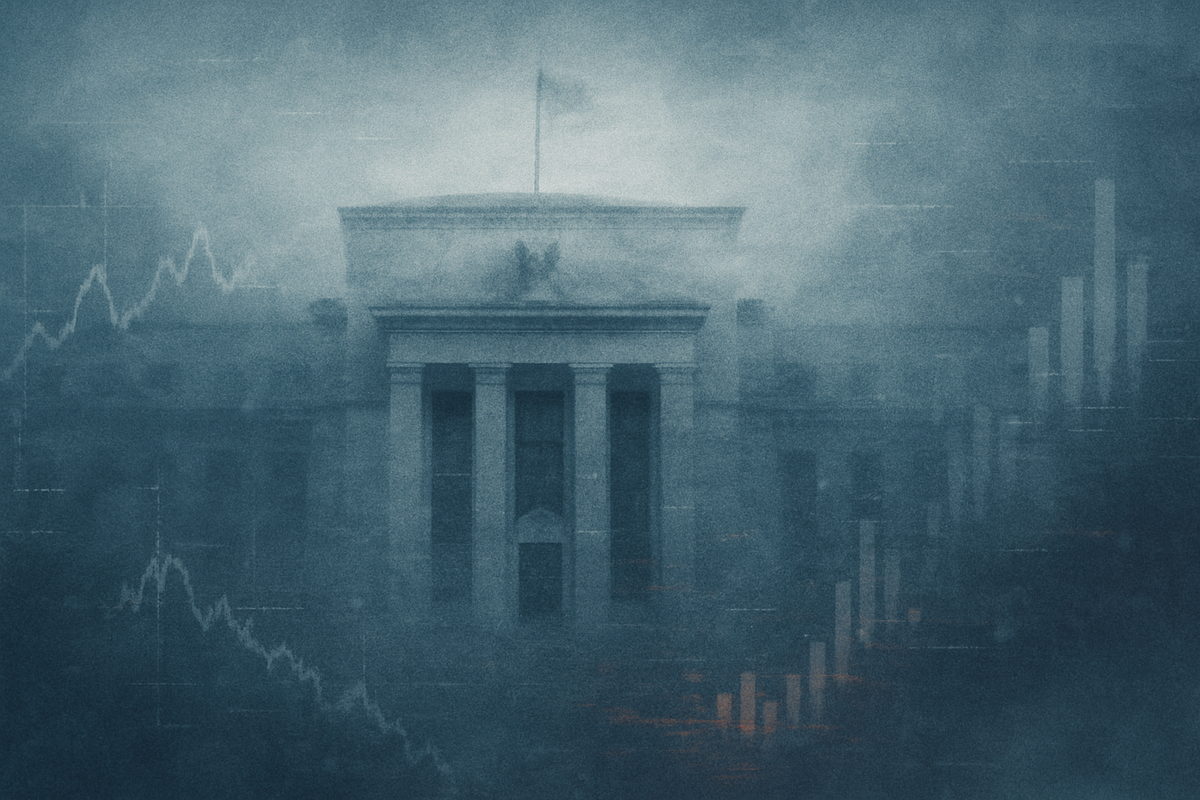
The recent, unprecedented 43-day government shutdown, which concluded on November 12, 2025, has plunged the Federal Reserve into a profound "data blackout," significantly obscuring its ability to accurately assess the U.S. economic outlook. This prolonged disruption, described as the longest in the nation's history, has severely curtailed the collection and release of critical economic statistics, leaving policymakers "driving in the fog" as they navigate crucial monetary policy decisions, including highly anticipated interest rate adjustments.
Detailed Coverage: An Unprecedented Data Drought
The shutdown, spanning from October 1 to November 12, 2025, brought the operations of key federal statistical agencies to a grinding halt. Bodies such as the Bureau of Labor Statistics (BLS) (NYSE: BLS), the Bureau of Economic Analysis (BEA) (NYSE: BEA), and the Census Bureau, responsible for the nation's most vital economic indicators, suspended their functions. This immediate cessation of activities led to the unprecedented delay, and in some cases, the potential permanent loss, of October's crucial economic reports. Among the most impactful delays were the monthly jobs report, unemployment rates, Consumer Price Index (CPI) and Personal Consumption Expenditures (PCE) inflation data, and initial estimates of Gross Domestic Product (GDP). The White House itself indicated that some of these October data points might "likely never" be released, creating an irreplaceable void in the economic record.
This recent event echoes, yet significantly surpasses, the impacts of previous shutdowns. The 2013 government shutdown, a 16-day impasse from October 1 to October 17, 2013, had already demonstrated the fragility of data flow, postponing the September jobs report and complicating the Fed's quantitative easing decisions under then-Chair Ben Bernanke. Similarly, the 35-day shutdown of 2018-2019 (December 22, 2018 – January 25, 2019) delayed over ten vital data releases, leading to a measurable reduction in real GDP growth for both the fourth quarter of 2018 and the first quarter of 2019. However, the 2025 shutdown's duration and the sheer volume of critical data affected represent a new level of challenge for the Federal Reserve (FED) (NYSE: FED) and financial markets.
The immediate reaction from the markets was one of heightened uncertainty and cautious recalibration. Prior to the shutdown, market expectations for a December interest rate cut were nearly certain. However, the ensuing data vacuum has led to a significant dimming of these expectations. Fed Chair Jerome Powell's (FED) (NYSE: FED) candid remark, "What do you do if you're driving in the fog? You slow down," succinctly captured the central bank's predicament, signaling a likely pause or more conservative approach to monetary policy in the absence of reliable economic signals. Economists and analysts are now scrambling to piece together an economic picture using alternative, often less comprehensive, data sources, highlighting the critical role of official government statistics in maintaining market stability and informed policy.
Companies Navigating the Data Fog: Winners and Losers
The 43-day government shutdown of 2025, coupled with the ensuing data blackout, has created a complex landscape for public companies, delineating clear winners and losers across various sectors. The disruption primarily stemmed from halted government functions and the severe curtailment of economic data, forcing businesses to operate with unprecedented uncertainty.
Companies heavily reliant on federal contracts bore the brunt of the shutdown's financial impact. Small and mid-sized government contractors, in particular, faced devastating cash flow disruptions, delayed payments for ongoing work, and the abrupt halting of new projects. Unlike federal employees who often receive back pay, contractors are generally not compensated for lost work during a shutdown, leading to significant financial strain and potential workforce reductions. Businesses providing IT services, consulting, or maintenance to federal agencies, especially those whose contracts were not fully funded or deemed "essential," experienced immense uncertainty regarding future business and revenue streams.
The "data blackout" proved to be a critical challenge for industries sensitive to economic indicators. Retailers such as Walmart (NYSE: WMT) and Target (NYSE: TGT) rely on consumer spending data, inflation trends, and employment figures for demand forecasting, inventory management, and pricing strategies. Without timely official reports, their ability to make informed decisions, particularly during the crucial holiday shopping season, was severely hampered. Similarly, manufacturers like General Motors (NYSE: GM) depend on data regarding economic growth and consumer demand to plan production and manage supply chains, leading to cautious hiring and investment in an uncertain environment. The housing sector, typically guided by housing starts and building permits, also faced significant delays in crucial data. Financial institutions, including major banks offering government-backed loans (e.g., FHA, VA, SBA), experienced delays in loan approvals and processing, frustrating small businesses and homebuyers. Investment banks and capital markets also felt the pinch, with the Securities and Exchange Commission (SEC) (NYSE: SEC) operating with limited staffing, causing delays in reviews of mergers, acquisitions, and initial public offerings (IPOs), thereby hindering capital-raising activities.
Conversely, a few sectors and companies were relatively insulated or even saw alternative investment interest. Large defense contractors, such as Lockheed Martin (NYSE: LMT) and Northrop Grumman (NYSE: NOC), often operate on long-term, pre-funded contracts deemed essential for national security, allowing them to maintain operations with less disruption. In times of heightened political and economic uncertainty, investors often seek safe-haven assets, leading to increased demand for gold, other precious metals, and government bonds, which can see their prices rise. While the overall economic impact was largely negative, these specific areas demonstrated a degree of resilience or even benefited from the market's flight to safety.
Broader Implications: A Stressed Economy in a Data Vacuum
The 2025 government shutdown, spanning an unprecedented 43 days, has reverberated far beyond the immediate cessation of federal services, revealing profound wider implications for the U.S. economy, industry trends, and the very foundation of monetary policy. This prolonged lapse in appropriations not only curtailed government activity but also created a critical data vacuum that exposed systemic vulnerabilities and reshaped operational strategies across various sectors.
The shutdown occurred against a backdrop of existing economic challenges, including sluggish hiring, stubbornly elevated inflation, and persistent trade tensions. This confluence of factors amplified the shutdown's impact, demonstrating the U.S. economy's vulnerability to political gridlock. Experts estimated that each week of the shutdown could subtract approximately 0.1% from annualized GDP growth, with the six-week impasse projected to reduce fourth-quarter GDP growth by about 1.5 percentage points and result in an estimated $11 billion in permanently lost economic activity. Consumer sentiment plummeted to a three-year low in November 2025, reflecting widespread concerns over personal finances and business conditions, a sentiment that could translate into reduced spending and slower growth in the months ahead. The disruption also highlighted broader industry trends, notably an accelerated shift towards reliance on private-sector data. With official government statistics delayed or potentially lost, businesses and investors increasingly turned to "private label data" from sources like Homebase and Indeed for real-time insights. While valuable, these alternative data sources often come at a cost, lack the comprehensive scope and unbiased nature of federal statistics, and cannot fully replace the robust federal statistical system.
The ripple effects extended to various partners and competitors. Businesses reliant on federal permits, loans, or contractual agreements, particularly those serving agencies like the Department of Defense (DOD) (NYSE: DOD), NASA (NYSE: NASA), and the Department of Homeland Security (DHS) (NYSE: DHS), faced significant operational hurdles and financial risks. Investment advisors, hedge funds, and banks, whose strategies are deeply rooted in government economic data for portfolio construction and asset allocation, grappled with heightened market uncertainty and impaired forecasting abilities. Local economies, especially those with high concentrations of federal employees, experienced reduced consumer spending due to missed paychecks, impacting local businesses, restaurants, and retail. Even essential services like air traffic control, though maintained, faced staffing stress, leading to thousands of flight cancellations and significant economic costs for the airline industry.
For the Federal Reserve (FED) (NYSE: FED), the regulatory and policy implications were particularly acute. As a "data-dependent" institution, the Fed relies on a steady stream of timely and accurate economic indicators to achieve its dual mandate of price stability and maximum employment. The absence of crucial data on inflation (CPI), employment (jobs reports), and consumer spending meant the Fed was "operating a little bit blind" or "driving in the fog" when assessing economic conditions. This uncertainty complicated their ability to make informed decisions about interest rates, potentially leading to delays or alterations in anticipated policy moves, such as the previously expected December 2025 interest rate cut. While the Fed itself is financially independent and continues to operate during a shutdown, its effectiveness is severely hampered by the lack of comprehensive economic intelligence, forcing it to proceed with extreme caution or rely on less robust information.
Historically, government shutdowns have consistently resulted in reduced GDP growth and some permanently lost economic activity, with the 2018-2019 shutdown reducing economic output by $11 billion over two quarters, $3 billion of which was unrecoverable. The 2013 shutdown similarly slowed GDP growth. The 2025 shutdown, being the longest, follows this pattern but in a more challenging economic climate. The increasing frequency of these impasses underscores a growing pattern of political gridlock affecting government funding, a trend that began with the legal opinions of the early 1980s requiring agencies to cease non-essential functions. This repeated disruption highlights the need for more stable and predictable government funding mechanisms to safeguard economic stability and the integrity of national economic data.
The Road Ahead: Navigating the Post-Shutdown Fog
The conclusion of the 2025 government shutdown on November 12 has ushered in a period of intense economic scrutiny and uncertainty, with the "data dark age" expected to cast a long shadow over the U.S. economy well into 2026. Both businesses and policymakers face immediate and long-term challenges as they grapple with incomplete information and the lingering effects of disrupted federal operations.
In the short term (late 2025 to early 2026), the economy will witness a gradual, yet often volatile, return of economic data. While some September data might be released relatively quickly, October's crucial jobs and inflation reports, which were not collected, face the grim prospect of permanent loss, leaving irreparable gaps in the economic record. This "data fog" will force the Federal Reserve (FED) (NYSE: FED) to operate with extreme caution, potentially delaying or altering anticipated monetary policy decisions, such as interest rate adjustments, due to the lack of reliable inputs. The Congressional Budget Office (CBO) (NYSE: CBO) estimates a short-term rebound in Q1 2026 GDP growth as government activity resumes, but this will not fully offset the estimated $11 billion in permanently lost economic activity from the shutdown. Consumer spending, already dampened by plummeting sentiment, is expected to remain subdued, impacting the crucial holiday shopping season and early 2026 retail performance.
Looking further ahead into 2026 and beyond, the implications are more structural. The prolonged data blackout could impede the effectiveness of future economic policy decisions, as the foundational information for analysis is compromised. This erosion of trust in the federal statistical system may accelerate the trend of businesses and financial institutions increasingly relying on private-sector alternatives, leading to a more fragmented and potentially less transparent economic information landscape. For businesses, strategic pivots are imperative: robust cash flow management and building significant cash reserves (3-6 months of operating expenses) will become standard practice, particularly for government contractors. Diversifying revenue streams, enhancing operational flexibility through digital transformation, and rigorous scenario planning will be crucial to mitigate the impact of future disruptions. For policymakers, especially the Fed, adaptable decision-making frameworks that incorporate a broader range of "hard" and "soft" data (e.g., credit card data, private surveys, satellite imagery) will be essential, coupled with increased transparency about internal assessments in the absence of official figures.
Market opportunities will emerge amidst the challenges. Defensive sectors like healthcare and utilities may see increased interest due to their stability. While initially hit, government-linked industries could experience a rebound and catch-up spending once agencies are fully operational. Safe-haven assets like gold and U.S. Treasuries may continue to attract investors amidst ongoing political and economic uncertainty. Furthermore, companies specializing in alternative data, predictive analytics, and business resilience solutions are poised for significant growth as the market seeks innovative ways to navigate data gaps. Conversely, challenges will include heightened market volatility as delayed data trickles out, continued uncertainty in monetary policy, and potential mispricing of assets without reliable official benchmarks. Lingering regulatory backlogs will also continue to impact dealmaking and business expansion well into 2026.
Ultimately, the U.S. economy faces a choice of scenarios for 2026. A gradual stabilization and partial recovery could see the economy slowly mend, with intermittent market jitters from data releases, but with permanent economic losses. A more pessimistic outcome involves prolonged uncertainty, stifled growth, and further erosion of international trust, leading to a higher "political risk premium" in asset valuations. However, there's also an opportunity for accelerated innovation, where the shutdown acts as a catalyst for significant advancements in alternative data and business resilience strategies, pushing private firms to fill the data void with innovative solutions. Regardless, agility, adaptability, and a proactive approach to information gathering will be paramount for all market participants in the coming months.
The Lingering Aftermath: Navigating Persistent Uncertainty
The 2025 government shutdown, a record-setting 43-day impasse that concluded on November 12, has left an indelible mark on the U.S. economic landscape, fundamentally influencing the Federal Reserve's (FED) (NYSE: FED) outlook and creating a complex environment for market participants well into 2026. While the immediate crisis has passed, its ripple effects, particularly the enduring "data fog" and persistent fiscal policy debates, will continue to shape economic trajectory and investor sentiment.
Key takeaways from this unprecedented event underscore the fragility of economic stability in the face of political gridlock. The shutdown, triggered by a congressional failure to pass appropriations legislation and disputes over expanded Affordable Care Act (ACA) subsidies, led to the furlough of approximately 900,000 federal employees and two million working without pay. Beyond the immediate financial hardship and disrupted government services—from flight cancellations to interruptions in food aid—the most profound impact was the halting of crucial economic data releases. Agencies like the Bureau of Labor Statistics (BLS) (NYSE: BLS) and the Bureau of Economic Analysis (BEA) (NYSE: BEA) ceased operations, creating a "data blackout" that left the Federal Reserve and investors "flying blind" at a critical juncture. The Congressional Budget Office (CBO) (NYSE: CBO) estimated a 1.5 percentage point reduction in annualized Real Gross Domestic Product (GDP) growth for Q4 2025, with an estimated $11 billion in permanently lost economic activity, signaling a tangible and lasting cost.
Assessing the market moving forward, the initial post-shutdown rally proved fleeting, quickly giving way to renewed uncertainty as the implications of the data vacuum became clearer. Historically, stock markets have shown resilience during shutdowns, but the 2025 event's record duration and its severe impact on consumer sentiment, which tumbled to a three-year low, present a more significant challenge. While economists project a rebound in Q1 2026 GDP growth, this will not fully compensate for the permanent economic losses. The Fed's economic outlook remains clouded; despite an October rate cut, the absence of real-time jobs and inflation data complicates further monetary policy adjustments, raising questions about the timing and extent of future interest rate cuts. Governor Christopher J. Waller (FED) (NYSE: FED) acknowledged the data challenge, though suggesting it was "overstated in many quarters," yet the consensus remains that informed decision-making is significantly hampered.
The lasting significance of the 2025 shutdown stems from a multi-pronged impact: an erosion of public and business confidence in government stability, persistent data uncertainty that will complicate analyses well into early 2026, and ongoing fiscal concerns. The temporary nature of the funding deal until January 30, 2026, means the specter of another shutdown looms, perpetuating fiscal instability. Elevated U.S. interest costs and a widening deficit further compound these concerns, with credit rating agencies already warning of potential sovereign rating pressures from repeated fiscal impasses.
For investors in the coming months (late 2025 and 2026), vigilance will be key. First, closely monitor the delayed release of economic indicators for October and November 2025; these will be crucial for a clearer picture of the shutdown's full impact. RBC Economics (NYSE: RY) anticipates a clean economic read might not be available until Q2 2026 data is released in July. Second, pay close attention to the Federal Reserve's statements and upcoming meetings, particularly the December session, as the "data fog" will likely induce a cautious approach to monetary policy. Third, watch congressional negotiations leading up to the January 30, 2026, funding deadline, as the potential for renewed fiscal battles could trigger significant market volatility. Fourth, consider sector-specific performance; while the broader market impact is often temporary, government contractors and industries dependent on federal permits may experience continued volatility, while consumer-focused sectors could see a rebound. Finally, keep a keen eye on consumer sentiment indicators, as sustained low confidence could translate into more cautious spending, a major driver of GDP. The 2025 shutdown serves as a stark reminder that political stability is an often-underestimated cornerstone of economic health, and its absence creates a complex and challenging environment for all.
This content is intended for informational purposes only and is not financial advice






